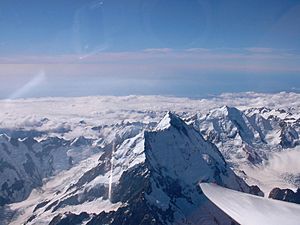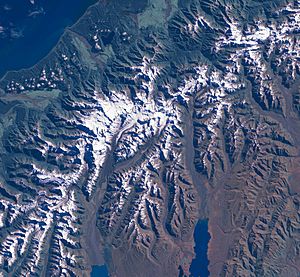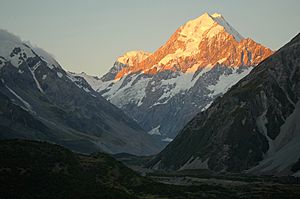Mount Cook facts for kids
Aoraki / Mount Cook is the highest mountain in New Zealand. It's about 3,724 meters (12,218 feet) tall. This giant mountain is part of the Southern Alps, a long mountain range that stretches across the South Island. Aoraki / Mount Cook is a popular spot for tourists and a big challenge for mountain climbers. It has three main peaks: the Low Peak, Middle Peak, and High Peak. These peaks are located near the Tasman Glacier to the east and the Hooker Glacier to the southwest.
Contents
Where is Aoraki / Mount Cook?
The mountain is found inside the Aoraki / Mount Cook National Park, which is in the Canterbury Region. This park was created in 1953. It's part of a bigger group of parks, including Westland National Park, Mount Aspiring National Park, and Fiordland National Park. Together, these parks form a UNESCO World Heritage Site. The park has over 140 peaks taller than 2,000 meters (6,562 feet). It also has 72 named glaciers, which cover 40 percent of its 700 square kilometers (173,000 acres).
Aoraki / Mount Cook is at the northern end of the Mount Cook Range. It forms a huge mountain block between the Hooker Valley to the southwest and the Tasman Valley to the east. These two valleys offer the best and easiest views of the mountain. You can get a great view of the whole mountain from a lookout point at the end of the Hooker Valley Track, which is only 10 kilometers (6 miles) from the peak.
The small town of Mount Cook Village is a tourist hub and a base for climbers. It's about 7 kilometers (4 miles) from the end of the Tasman Glacier. It's also 15 kilometers (9 miles) south of Aoraki / Mount Cook's summit.
On clear days, you can see Aoraki / Mount Cook from far away. It's visible from the West Coast as far north as Greymouth, which is about 150 kilometers (93 miles) away. You can also see it from most of State Highway 80 along Lake Pukaki and State Highway 6 south of Lake Pukaki. The mountain's three peaks form a unique blocky shape when seen from the east or west. Another famous viewpoint is from Lake Matheson on the West Coast. On calm days, the peaks of Aoraki / Mount Cook and Mt Tasman reflect perfectly in the lake.
Weather Around the Mountain
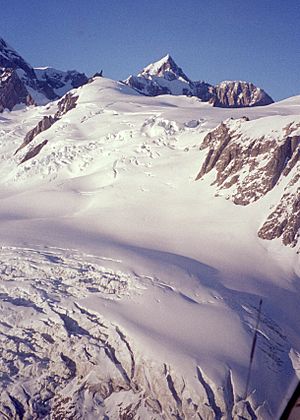
Aoraki / Mount Cook gets a lot of rain and snow all year round. This is because strong, moist westerly winds blow from the Tasman Sea. These winds bring rainclouds with them. The amount of rain and snow changes a lot around the mountain. This is due to weather systems moving from the Tasman Sea.
The Aoraki / Mount Cook mountain range is a huge barrier for these westerly winds. As the moist air rises up the mountain, it cools down and forms clouds. Rain and snowfall are often heaviest around 1,200 meters (3,937 feet) high. This can last for several days if the weather system moves slowly.
Because of these weather patterns, the western slopes of Aoraki / Mount Cook can get over 10,000 mm (394 inches) of rain each year. In comparison, Mount Cook Village, which is only 15 kilometers (9 miles) south of the mountain, gets 4,484 mm (176.5 inches) of rain or snow.
The weather on the eastern side of the mountain is usually better. However, rain or snow can quickly spread to that side if the wind changes to the south or southeast. This causes a fast drop in temperature and poor visibility. This makes climbing conditions on Aoraki / Mount Cook even harder.
Temperatures at the base of the mountain, in the Hooker Valley (around 800 meters or 2,625 feet high), range from -13°C (9°F) to 32°C (90°F). Generally, the temperature drops by just over 1°C (1.8°F) for every 200 meters (656 feet) you go higher.
From about 1,000 meters (3,281 feet) and higher, there are permanent snow and ice fields in winter. Winter and spring usually have less stable weather than summer and autumn. In summer, high-pressure systems often bring clear, settled days. In winter, they can bring clear, cold conditions with severe frost.
Name and European Discovery
In the traditions of the Ngāi Tahu iwi (tribe), an old name for the South Island is Te Waka o Aoraki ('Aoraki's Canoe'). Many people used to think Aoraki meant "Cloud Piercer." This comes from the Māori words ao (cloud) and raki or rangi (sky). In the past, the Māori name was often spelled Aorangi.
Māori people knew about Aoraki / Mount Cook after they arrived in New Zealand around the 14th century CE. The first Europeans who might have seen Aoraki / Mount Cook were part of Abel Tasman's crew. On December 13, 1642, they saw a "large land uplifted high" off the west coast of the South Island. The English name Mount Cook was given to the mountain in 1851 by Captain John Lort Stokes. He named it to honor Captain James Cook, who explored and sailed around New Zealand in 1770. Captain Cook himself did not see the mountain during his travels.
After a special agreement between Ngāi Tahu and the New Zealand government in 1998, many place names in the South Island were changed. This was done to include their Māori names. The mountain's name was officially changed from Mount Cook to Aoraki/Mount Cook. This was to include its historic Māori name. It is the only one of these names where the Māori name comes before the English name. As part of the agreement, the government agreed to give the ownership of Aoraki / Mount Cook to Ngāi Tahu. Ngāi Tahu would then give it back to the nation as a gift. These transfers have not happened yet. Ngāi Tahu can decide when this will take place.
How the Mountain Was Formed
The Southern Alps in the South Island were formed by powerful tectonic forces. This happened as the Pacific and Indo-Australian Plates crashed into each other along the island's western coast. The land is still rising, making Aoraki / Mount Cook grow taller by about 7 mm (0.3 inches) each year. However, natural forces like erosion also shape the mountains. The extreme weather is because the mountain sticks up into the strong westerly winds of the Roaring Forties. These winds blow around 45°S latitude, south of Africa and Australia. The Southern Alps are the first big obstacle these winds meet after South America.
The height of Aoraki / Mount Cook was first measured in 1881 and again in 1889. Both measurements were very close, at about 3,764 meters (12,349 feet). But the height was reduced by 10 meters (33 feet) when a huge amount of rock and ice fell off the northern peak on December 14, 1991. Over the next two decades, more ice melted, reducing the height by another 30 meters (98 feet) to 3,724 meters (12,218 feet). This was found by new GPS data in 2013.
Aoraki / Mount Cook is located in the middle of the Alpine Fault. This is a 650-kilometer (404-mile) long active fault in the Southern Alps. It is responsible for the mountain rising. Scientists believe it moves every 100 to 300 years. It last moved in 1717.
Forests and Glaciers Around Aoraki / Mount Cook
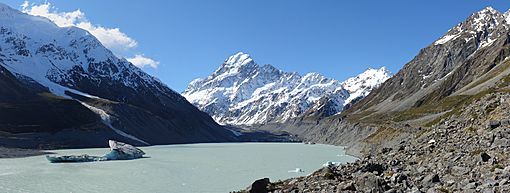
The lowlands around the mountain, especially to the west, get a lot of rain. The average annual rainfall is around 5 to 10 meters (197 to 394 inches). This very high rainfall leads to rainforests in these coastal areas. It also provides a steady supply of snow in the mountains, which keeps the glaciers flowing. These glaciers include the Tasman Glacier to the east and the smaller Hooker Glacier to the south.
The plants in the valleys to the east, like the Tasman Valley, are not as thick as those on the western slopes. Forests would normally grow up to about 1,300 meters (4,265 feet) high here. However, there isn't enough soil because of loose rocks and the effects of glaciers. Snow tussock and other alpine plants can grow as high as 1,900 meters (6,234 feet).
Above the snowline, you can only find lichen among the rocks, snowfields, and ice. These cover the highest parts of Aoraki / Mount Cook.
Climbing History
The first recorded attempt to reach the top was in 1882. It was made by Rev. William S. Green, Emil Boss, and Ulrich Kaufmann. They got very close to the summit. Another attempt in 1890 by Mannering and Dixon also came within a few feet of the top.
The first known time someone reached the summit was on December 25, 1894. Three New Zealanders, Tom Fyfe, John Michael (Jack) Clarke, and George Graham, made it to the top. They climbed via the Hooker Valley and the north ridge. They were determined to be the first New Zealanders to reach the summit. This was because they heard that American climber Edward FitzGerald was also trying. The group reached the top around 1:30 PM, full of excitement. The path they took was so hard that it wasn't climbed again for over 60 years, until 1955.
Swiss guide Matthias Zurbriggen, who was part of FitzGerald's team, made the second climb on March 14, 1895. He climbed from the Tasman Glacier side, using the ridge that is now named after him. This is known as the first solo climb, even though J Adamson joined Zurbriggen for part of the way. After Zurbriggen's climb, it was another ten years before anyone climbed the mountain again. In February 1905, Jack Clarke and four others completed the third climb, using Zurbriggen's route. This made Clarke the first person to climb the mountain more than once.
The first woman to climb the mountain was Australian Freda Du Faur on December 3, 1910. George Bannister, a local guide and a nephew of another guide, Butler Te Koeti of Ngāi Tahu, was the first Māori to successfully climb the peak in 1912.
A climb across all three peaks was first achieved in 1913 by Freda Du Faur and guides Alec and Peter Graham. This 'grand traverse' was repeated in January 1916 by Conrad Kain, guiding 57-year-old Jane Thomson. This was seen as an amazing feat at the time.
Sir Edmund Hillary made his first climb in January 1948. In February 1948, with Ruth Adams, Harry Ayres, and Mick Sullivan, Hillary made the first climb of the South Ridge to the Low Peak. To honor Hillary, the South Ridge was renamed Hillary Ridge in August 2011.
Aoraki/Mount Cook is a very challenging mountain to climb. It has a lot of ice and glaciers. Its difficulty is often underestimated. Conditions can change very quickly depending on the weather, snow, and ice. The climb involves crossing large cracks in the ice (crevasses). There are also risks of ice and rock falling, avalanches, and fast-changing weather.
Since the early 1900s, about 80 people have died trying to climb the mountain. This makes it New Zealand's most dangerous peak. The climbing season usually runs from November to February. Almost every season, at least one person dies.
Māori Legends and Traditions
According to Māori legend, Aoraki was a young boy. He and his three brothers were the sons of Rakinui, the Sky Father. They were on a journey around Papatūānuku, the Earth Mother. Their canoe got stuck on a reef and tipped over. Aoraki and his brothers climbed onto the top side of their canoe. But the south wind froze them and turned them into stone. Their canoe became Te Waka o Aoraki, which is the South Island. Their canoe's front parts became the Marlborough Sounds. Aoraki, who was the tallest, became the highest peak. His brothers created the Kā Tiritiri o te Moana, which are the Southern Alps.
Ngāi Tahu, the main iwi (tribe) of New Zealand's southern region, see Aoraki as the most sacred of their ancestors. Aoraki gives the iwi a sense of community and purpose. He remains the physical form of Aoraki and connects the worlds of the supernatural and nature.
Images for kids
See also
 In Spanish: Monte Cook para niños
In Spanish: Monte Cook para niños


